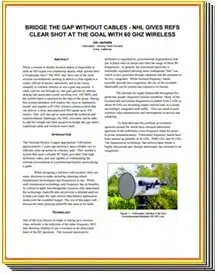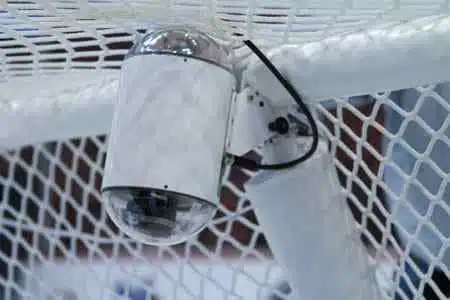
Sports HD Video
Custom Sports Video Camera for HD Broadcast Solutions
Custom Sports Broadcasting Solutions:
Being able to officially review sports plays or scoring opportunities has become a common practice in today’s highly competitive sports environment.
The need for flexible equipment in support of officiating professional sports can be seen at a league level and is making its way down to the collegiate level. We at VidOvation understand these needs and have customized solutions to serve some of the most demanding sports environment . The NHL approached us with a very complex need and we delivered. You will find our camera’s inside the nets of every NHL venue.

Download the Guide
Explore ways to wirelessly broadcast in a remote, hostile environment.
The NHL may have one of the most extreme environments needing to deliver a clear signal to a replay official at headquarters, not at the venue, instantly to confirm whether or not a goal was scored. A cable can’t be run through ice, the goal gets hit by athletes skating full speed and a puck traveling over 100 MPH, and the mobile band is saturated by the fans in the arena.
Explore the ways to implement, install, and support a 60GHZ wireless camera system that can deliver a clear, uncompressed HD signal up to 500 meters.
Excerpt of Our NHL Case Study – Bridge the Gap without Cables – 60GHz Wireless
ABSTRACT:
When a remote or hostile location makes it impossible to send an HD signal over traditional means, what options does a broadcaster have? The NHL may have one of the most extreme environments needing to deliver a clear signal to a replay official at hockey operations, not at the venue, instantly to confirm whether or not a goal was scored. A cable can’t be run through ice, the goal gets hit by athletes skating full speed and a puck traveling over 100 MPH, and the mobile band is saturated by the fans in the arena. During this session attendees will explore the ways to implement, install, and support a 60 GHz wireless camera system that can deliver a clear, uncompressed HD signal up to 500 meters. They will also get to understand the technical and implementation challenges the NHL overcame and be able to add this insight into their projects to bridge the gap where traditional cable and wireless won’t work.
INTRODUCTION:
The National Hockey League approached VidOvation approximately 3 years ago seeking a more reliable way to officiate close-up action in a hockey goal. They needed a system that used a reliable RF band, provided 720p high definition video, and was capable of withstanding the extreme environment of a professional hockey arena during a game. When designing a wireless video system, there are many decisions to make including choosing which transmission technologies and frequencies to use. While each transmission technology and frequency has its benefits, it is critical to apply knowledgeable resources that understand the technology trade offs and can provide a detailed analysis to help you make the right choices that balance application needs with the available budget. The rest of this paper will discuss the most pressing trade offs that need to be made.
TECHNOLOGY:
One of the first choices to make in setting up a wireless video network is the selection of the radio frequency (RF) and choosing whether to use a licensed or an unlicensed band of the RF spectrum. The licensed spectrum by definition is regulated by governmental organizations that put in place rules to assign and limit the usage of those RF frequencies. In general, the unlicensed spectrum is minimally regulated allowing more widespread “free” use which in turn generates broader adoption and the potential to be very congested. While licensed frequency bands typically provide less congestion, the use of the available bandwidth can be limited and expensive to license. The demand for higher bandwidth throughout the globe has greatly impacted wireless reliability. Many of the licensed and unlicensed frequencies available from 2 GHz to about 40 GHz are becoming highly utilized and, as a result, increasingly congested with traffic. This can result in poor wireless video transmission and interruptions in service and reliability. To help alleviate this problem government agencies around the world have released unlicensed spectrum in the millimeter wave frequency band for point-to-point communications. Unlicensed frequency bands have been opened up globally at 60 GHz, 70/80 GHz and 90 GHz. The transmission technology that utilizes these bands is highly directional and, though unlicensed, has minimal to no congestion.

